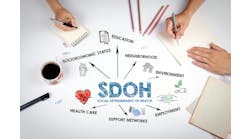COVID-19 has presented state and local governments with an urgent need for data to identify citizens’ needs and direct resources appropriately. Those that have already started sharing data across sectors may have a head start. “This crisis can be the wakeup call for us to kick-start multi-sector collaboration, including building a platform for data sharing or for scaling up an existing collaboration to mount an effective response to COVID-19,” said Irene Vidyanti, a data scientist for the Los Angeles County Department of Public Health.
Vidyanti was speaking during a webinar put on by All In: Data for Community Health, a nationwide learning collaborative that helps communities build capacity to address the social determinants of health through multi-sector data-sharing collaborations.
In bringing together leaders from Los Angeles, Chicago and Cleveland, the All In network noted that its work focusing on the most vulnerable populations has become more valuable than ever. Multi-sector data sharing and collaboration can make contributions to address the underlying conditions that make some even more susceptible to the outbreak.
Los Angeles County has been working for years to break down data silos between different departments. Vidyanti and Ricardo Basurto-Davila, principal analyst in the LA County Office of the Chief Information Officer, described the setup and how it is being used during the COVID-19 crisis.
Basurto-Davila noted that LA County serves more than 10 million people and has 38 departments. Each has its own information system, and most have many information systems. “Some are very old. Some are doing things they were not designed to do. This creates a situation where there are all kinds of data silos,” he said. It can be difficult to get the data, and there are issues with the quality and timeliness of the data. “So for several years, LA County has been trying to create a system that allows us to make better use of this data to improve operations and coordinate services and care when we know many individuals are seen by many departments for different purposes.”
The county has built an enterprise-wide information hub with two main goals. One is to enable service coordination. “This allows us to effectively managing information, understanding what the person’s needs are, and seamlessly referring them and getting them connected to services,” Basurto-Davila “The second goal is the analytics side — to inform decision making. We rely on our enterprise information management system to help the county department decision makers make better decisions on how to improve services for citizens.”
The county information hub is composed mainly of two elements. One is a countywide master data management system with an identity resolution system that creates a unique enterprise ID across systems. “That took a lot of effort, conversations with lawyers, trust building, and explaining the value for agencies and the county as a whole,” he said. “It took quite a bit of time.”
The second big element is a data store that receives information from departments on services and encounters with clients linked to that enterprise ID. Analysts then use that data to work on improving care coordination and reduce inappropriate use of services.
Vidyanti then described how the system is being put to use during the COVID-19 crisis.
“We need the data to mitigate the risk of spreading the disease,” she said. “With unemployment on the rise, there are reports of increasing financial and food insecurity, domestic violence and depression. This crisis has resulted in increased needs of county clients. The county needs to identify who these clients are so we can improve care coordination and deliver needed services. This is important because as demand for county services has increased, the crisis has strained many nonprofits that usually play an important role in helping them.”
The Department of Public Health (DPH) and the Los Angeles Homeless Services Authority (LAHSA) are exploring how to use linked data to identify homeless clients who have tested positive for COVID-19, so that LAHSA can target their outreach efforts to these individuals and contact homeless shelters where they reside to minimize their contact with others to prevent outbreaks. “The linked data in this case is LAHSA data to identify homeless clients and which shelters they are residing in, and DPH data to identify confirmed COVID-19 positive cases from the public health laboratory data,” Vidyanti explained. “Our office facilitates the data linkages and sharing using the Info Hub. Having this platform does enable easier data sharing since we have done the homework of building the technology and navigating the legal pathway and data-sharing agreements and relationship-building required. This presents a structural advantage for us.” This use case doesn’t require something as sophisticated as the platform built in LA County, she added, and it might be an opportunity for other jurisdictions to start a similar collaboration on data sharing.
The county is also exploring the possibility of identifying who among the homeless clients with COVID-19 have higher risk profiles and are therefore especially vulnerable to complications. The CDC has listed certain comorbidities for hospitalizations and sever complications for COVID-19. By further linking the LAHSA, DPH data to the Department of Health Services data that contains diagnoses from prior hospitalizations and outpatient visits, they can identify patients who are vulnerable to complications because they have these comorbidities identified by CDC as risk factors. “This will allow us to identify efforts to reach these individuals so they can take steps to protect themselves and others, but also potentially prioritize care coordination and service delivery, housing placement and other services for individuals with higher risk profile,” Vidyanti said.
While the use case described focuses on homelessness and housing, Vidyanti noted that governments and agencies can used shared data in a similar manner for COVID-19 response in other sectors, such as the justice and social service sectors or child and family services to identify clients where there is a need to increase the frequency of check-in between case managers and clients, for instance, and prioritize services while also transforming the day-to-day interaction to reduce risk by making the check-in remote where possible and prioritizing certain services to contain spread of disease.
More generally, linked data can be used to identify clients with increased needs for targeted outreach and service delivery. “For instance, if we see a client newly applying for benefits during this time of crisis, that may mean they may require food assistance or other services, so the county may identify individuals for targeted outreach and service delivery,” she said.
Vidyanti suggested that other regions may want to be strategic about what data and what sector to focus on that would be most valuable during the crisis while still keeping an eye on what would be valuable for the future. “There are some considerations in building and scaling up such collaborations and data sharing,” she said. “Technology may be the most obvious part of the equation, but the legal framework and relationship building are even more critical.”
This crisis does create some enablers that can accelerate collaboration building, Vidyanti stressed. The types of data that can be shared in the event of a public health emergency are different from the usual situation. “I would point you to the Office of Civil Rights within the Department of Health & Human Services, which released a bulletin in February outlining what kind of data can be shared with whom and in what scenario in this COVID-19 crisis,” she said. “Consult your legal counsel about how this data-sharing landscape is changing in the crisis situation. A second enabler is that agencies are more willing to enter into these collaborations if they see a clear value in sharing data to address the COVID-19 crisis. But relationship building is still important because we need to be able to trust our partners.”


